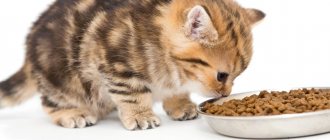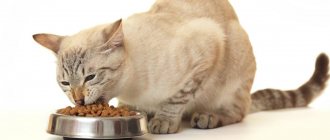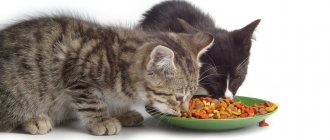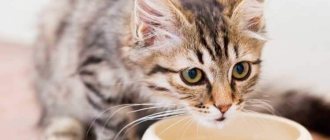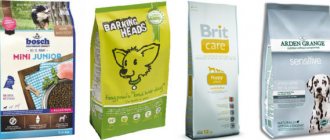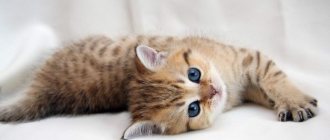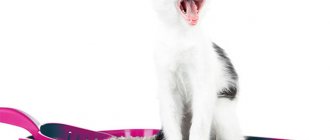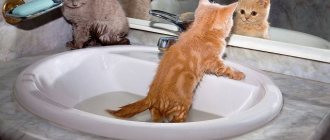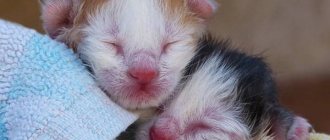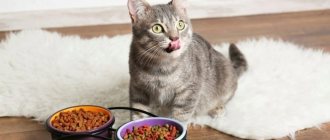After breastfeeding ends, the responsibility for feeding the furry pet is transferred to the owner. For full growth and development, a kitten requires not only nutrients, but also vitamins to strengthen the bone structure. Any mistake is fraught with health problems and even the death of a fragile pet. The owner will have to understand the nuances of different types of nutrition, recommended modes and portion sizes.
Tables of norms by age
In order to make it more convenient to understand how many times a day a small kitten should be fed, we have compiled both the amount of food and the number of feedings per day into a single table.
| Kitten age | Amount of food per day in grams (it is divided into equal-sized portions for as many feedings as the pet’s age requires) | Number of feedings per day |
| 4-8 weeks | 120 | 7 |
| 8-112 weeks | 160-180 | 6 |
| 12-20 weeks | 180-240, with a minimum meat volume of 40 g | 5 |
| 5-9 months | 180-200 | 4 |
| 9-12 months | 180-200 | 3 with gradual transition to 2 by age 1 year |
For each kitten, the norms may vary slightly depending on its individual characteristics. However, it is necessary to use them as a guide, since otherwise the pet may not receive enough nutrition or, conversely, be overfed, and obesity in cats poses a great danger, leading to the rapid development of pathologies of internal organs.
Claws
In principle, you can do nothing at all with claws, if you don’t feel sorry for the furniture upholstery. Otherwise, you will have to wean your pet from the habit of tearing up everything. You can do this in several ways:
- buy a scratching post, spray it with catnip that is attractive to these pets, and teach how to use it by smoothly running your paws with extended claws over the surface of the device (often scratching posts are already sold impregnated with special compounds to attract the attention of cats);
- put caps on the claws and monitor the kitten’s reaction (whether it will be comfortable for him to wear them);
- trim the claws, cutting the length no more than 1 mm from the edge, so as not to cause pain to the kitten.
These measures will be enough to try to protect furniture upholstery and wallpaper from tearing.
By month
At each age, a kitten’s nutrition has its own characteristics. Not only the portions and frequency of giving food change, but also its composition. Its future health depends on how well a cat eats in childhood. When a kitten is purchased from a breeder, he gives the owner the necessary recommendations on the pet’s nutrition that should be followed.
Natural food
Natural food for kittens and cats is chosen more often than industrial food. Some breeders raise babies on natural food for up to 2-3 months, and then gradually switch to industrial diets, since their use is more convenient for the owners.
Little kittens drink milk
from 1.5 to 2 months
The stomach and intestines of a one and a half month old kitten learn to digest food, and therefore the baby’s food should be easily digestible and not irritate the mucous membranes. Food is given liquid and semi-liquid.
Solid food is still prohibited during this period. If the cat has enough milk, then first the kitten is given fermented milk products with egg yolk. The boiled yolk is pounded and mixed with fermented baked milk or yogurt.
After the first week of such complementary feeding, they begin to give meat puree (if the cat does not have enough milk, then they begin to give puree at the same time as dairy products). It is prepared from lean boiled meat, which is ground in a blender and mixed with a small amount of broth to give the food the desired semi-liquid consistency. When the kitten begins to eat confidently enough, which usually happens closer to 2 months, you can give the meat without adding broth and grind it less finely.
Be sure to prepare liquid porridge. They are boiled in water or milk, which is diluted half with water. You can give kittens buckwheat, rice and oatmeal, after grinding them until a homogeneous mass with the consistency of fermented baked milk is obtained. The porridge should be prepared without salt and sugar. It is useful to add a little honey to it to enrich it with vitamins and minerals.
For your information! Kittens at one and a half months old need to change their water at least 2 times a day.
2 to 3 months
At this time, you can move on to feeding denser foods. For a two-month-old kitten, the boiled meat is already finely chopped, and grated carrots, pumpkin or cucumbers are added to it. Porridges are prepared in the same way as in the previous age with a large amount of liquid, but it is no longer necessary to grind the cereals too much. The porridge should remain liquid, and a homogeneous mass is no longer required.
Advice! Milk and dairy products should account for 50% of the diet.
It is impossible to reduce the number of feedings to less than 6. If the owner’s work schedule does not allow him to provide the pet with regular food, then it is necessary to resort to the free feeding method. In such a situation, the kitten should always have a small amount of fermented baked milk or kefir in its bowl so that it can eat as soon as it feels hungry. In this case, full feeding is carried out at least 4 times. This method is treated as an exception, therefore, if it is possible to feed the kitten regularly, it should not be used.
3 to 4 months
At this age, the kitten is already beginning to adapt to eating adult food. The amount of dairy products in his diet is reduced to ¼ of the total. Whole milk is gradually completely eliminated from the diet. This is due to the fact that by this age the enzyme that ensures the breakdown of lactose ceases to be produced, and therefore milk begins to cause digestive problems and diarrhea. Porridge is also cooked with plenty of water and the cereal is not ground. The meat is no longer cut so finely. Vegetables are still provided.
Whiskas dry food
4 to 5 months
The diet becomes the same as that of adult cats, but the supply of food still remains more frequent than theirs. The consistency of the food also differs.
It still shouldn't be very stiff. Porridges are prepared with a moderate amount of water, and the meat is cut quite coarsely. Among dairy products, preference is given to cottage cheese with a fat content of 5 to 9%.
There are cats that eat soft and liquid food all their lives. This is not a deviation. If the kitten, in the absence of pathologies, refuses solid foods, then you should simply continue feeding food with the same consistency as before.
5 to 6 months
The vast majority of a cat's diet consists of solid food. Porridge is prepared according to standard standards, as for humans. Little by little, the pet begins to be offered pieces of lean raw meat. Cats are carnivores, and they need this diet to maintain a healthy stomach. Otherwise, feeding remains the same as up to 5 months.
From 6 to 12 months
The main difference between a kitten’s diet at this age is the inclusion of a significant amount of raw meat in the diet. It should be at least 50% of the total volume of meat food. The rest of the diet is the same as before.
Industrial
You can feed a kitten with ready-made industrial food from an early age, since most reputable manufacturers have food for cats and products for babies in their lines.
1 to 2 months
During this period, feeding is carried out with special pates for kittens from a month to two months. They have a very delicate consistency that does not irritate the mucous membranes. Also during this period, cat milk substitutes are given if the cat does not have enough of it. The number of feedings per day is unchanged for both natural and industrial feeds. If the baby cannot yet start eating the pate because its consistency is not very liquid, then it should be diluted a little with boiled water. Gradually the amount of water is reduced so that by 2 months the pate is given in the form in which it is produced. If the pet eats food without adding water, then it is not required to use it, even at the very beginning of complementary feeding.
2 to 3 months
Dry kitten food is gradually added to the pate. They should definitely be soaked. This is required because the pet cannot yet fully chew hard pieces and there is a high risk that he will choke. The volume of soaked dry food should not exceed 20% of the total nutrition.
3 to 4 months
Pate for kittens is complemented by soft food, which is also intended for feeding babies. In addition, dry food is also given - slightly soaked at the beginning of the period, and dry at the end.
From 4 to one year
Pate is completely replaced with wet food. These can be portioned foods in bags or canned goods in jars. The latter option is cheaper, but after opening the product should be stored for no more than a day in the refrigerator, transferred to glass. Because of this, if the pet is a small one, jars may be inconvenient, since some of the food will remain uneaten and will have to be thrown away after a day. Dry food for kittens is no longer soaked.
From this moment onwards up to a year the diet remains the same. After 1 year, the cat becomes an adult, its active growth and development stops. From this age she should be given adult food. You need to choose a product from the same manufacturer as for the kitten. This will significantly speed up the period of your pet’s adaptation to the new diet. The cat should be switched to adult food gradually, replacing more and more of the kitten food with adult food every day for a week.
If you have spayed an older kitten, her diet should change. Read the special article on feeding sterilized cats.
Spiders for small kittens
Dry and wet food
In addition to classic dry food, you can use wet canned food. Together they compensate for each other's shortcomings: 75% of the diet is allocated to dry food, and 25% to wet food. This also has its own nuances, so before deciding what food to feed a 2-month-old kitten, compare the advantages and disadvantages of each method.
Advantages and disadvantages
Most of the disadvantages lie in low-quality economy class products. It is prepared from low-quality raw materials (bones, fats, skins, feathers) with an abundance of mineral salts, preservatives and flavorings. These ingredients have a detrimental effect on the cat’s body, provoking the development of urolithiasis.
If an allergy or other disease occurs that requires a change in food, it takes quite a long time (8-10 days) to mix new granules with the old ones in order to make a smooth transition. Abrupt transitions are excluded, as they can provoke gastrointestinal upset.
Safe and healthy products include premium, super-premium and holistic classes. Their advantages are:
- an abundance of different lines developed for individual breeds, as well as taking into account age characteristics and the presence of diseases;
- saving time on cooking;
- availability of daily allowances on each package;
- balance of composition;
- prevention of tartar and strengthening of the jaw muscles.
Dry granules take up little space, making them easier to take when traveling. It is easier to leave an animal with this type of food for foster care with relatives or friends. Even an elderly person with limited mobility can feed your pet.
Variety of food for kittens
When purchasing a furry family member through a breeder, check in advance what to feed your two-month-old baby. If the seller has already started feeding him a specific brand, then stick to the same brand for up to a year.
The most expensive granules and wet canned food belong to the holistic class. Despite their prestige, they are not suitable for animals with problems with the urinary system.
The best brands of kibble and canned food that have a line for kittens include:
- Hill's;
- Orijen;
- Happy Cat Junior;
- 1st Choice;
- Eukanuba;
- Royal Canin;
- ProNature;
- Purina ProPlan;
- Acana;
- Go Natural.
Wet canned food is served to your pet only when heated. Be sure to put any uneaten pieces in the refrigerator until the next feeding.
How to choose?
Avoid stores that sell pellets by weight. Once the package is opened, the shelf life is reduced. The quality of such a product is often questionable.
When choosing a brand, consider the manufacturer. Products from Russian factories are significantly inferior in quality. The safest producing country is Canada. Some Canadian food can even be eaten by humans.
Be sure to consult your veterinarian before purchasing. If there are diseases, he will offer a veterinary line.
Remember that you cannot save on ready-made food; eating budget brands will lead to the same problems as eating fast food.
Basic questions: is it possible
Experienced kitten owners usually have no questions about what can and cannot be given to their pet. When the first kitten appears in the house, its nutrition raises many questions.
They are overwhelmingly typical, and these are the ones that will be discussed further.
Canned food
Canned food that is designed specifically for cats, if they are age appropriate, can definitely be given to your pet, but only when the kitten already knows how to drink water on its own. When it comes to products for the master's table, they are completely prohibited.
This is due to the fact that they contain salt and spices that should not be given to cats. Canned food for people, even of the highest quality, poses a serious danger to a kitten.
Meat baby food and formula, how to dilute
Baby food is often used to feed kittens. For sucklings who are left without a mother, if it is not possible to purchase cat milk substitutes, high-quality infant formulas are used. They are diluted with water in a ratio of 1:1.5. Infant formula is also used if the kitten has diseases that do not allow it to eat normally. Some breeders also use milk formula for children to begin accustoming the baby to adult nutrition.
Meat baby food is a good replacement for special pates and mousses for kittens. The main thing is that such food does not contain any admixture of salt and starch. The most popular is Agusha meat puree, which is distinguished by its high quality and affordable price.
Cow's milk, what can you replace it with?
Kittens need milk until they are 3 months old. Natural boiled cow's milk is the best option. When this is not possible, you should use packaged milk from a non-perishable store. Its fat content should be from 3.2% to 6%. A low-fat product cannot be used.
You can replace cow's milk with goat's or sheep's. However, it will first have to be diluted with water in a 1:1 ratio. Only after making sure that the kitten’s body accepts it normally can it be possible to give the product in its pure form. Sugar-free concentrated milk is also suitable as a substitute. As a last resort, you can dilute powdered milk for the kitten. Cream with a fat content of 8-10% is given to kittens no more than 2 times a week, so as not to overload the liver and pancreas.
At what age is milk allowed?
You can start giving milk to kittens at 3 weeks. Until this age, they should receive mother's milk or, if it is not available, then substitutes. Enzymes for the digestion of whole milk will remain in the kitten for up to 3 months. Because of this, the product should only be given to your pet from 3 weeks to 3 months. Then it is replaced with fermented milk.
Sour cream is prohibited!
Sour cream
Sour cream is a high-fat product, which is why it is not suitable for kittens. His digestive system will not be able to cope with such a load, and diarrhea and vomiting will occur.
If you feed sour cream regularly, then there is a risk of problems with the liver and pancreas. Adult cats can sometimes be given a little sour cream with a fat content of no more than 15% as a treat.
Raw meat
Cats are carnivores by nature, and their diet must include raw meat. It begins to be given from the age of 5 months. You should purchase meat from trusted stores so that the quality of the product is always high. You can only give lean beef, rabbit, white chicken and turkey.
For your information! Pork is strictly prohibited for cats as well as for most dogs!
Dog food
Dog food is not suitable for cats as they have different nutritional needs. The former are omnivores, while cats are predators. Because of this, the amount of protein they receive must be significantly higher than what dogs need. Because of this, with constant feeding of dog food, the kitten will begin to develop systemic disorders, which pose a direct threat to its life. A single use will not harm the kitten. Because of this, you shouldn’t be afraid that your pet will grab food from the dog’s bowl, but you shouldn’t specifically feed it to the kitten. Proper nutrition for dogs is different from that for cats.
Dry food only
Most veterinarians recommend giving dry food to kittens only from the age of 2 months. Before this, the jaw apparatus is not yet strong enough to easily chew granules, and the intestines are more suitable for soft nutrition. If for some reason you have to give your baby dry food, then they should be soaked. It is not advisable to feed cats at any age only dry food. They should also receive wet food, as this is necessary to maintain a healthy stomach and intestines.
Adult for cats
Adult cat food should not be used for kittens. They do not contain all the substances necessary for a growing body, which is why the kitten will start to get sick. Also, such food is too rough for babies and can cause stomach problems. If you need to give food to adult cats once, they should first be soaked.
Warning! When feeding a kitten with prepared food, there is no need to additionally enrich its diet with vitamins and minerals, since they already contain everything they need.
Food from our table is strictly prohibited!!!
Homemade food from the table
Giving a kitten food from the owner's table is only permissible if the person follows a strict diet, when salt, sugar, spices, vinegar, spicy, fried and smoked foods are completely excluded from the diet. With a normal diet, the owner should not treat the pet with food from his table.
With such food, he will receive extra fats, calories and preservatives that are harmful to him, and spices, salt or sugar will negatively affect the functioning of the intestines and kidneys.
In families with children, you should immediately explain to them that you cannot feed the kitten from your plate - this will only make it sick.
Porridge
Porridge is of great importance in the diet of kittens. They provide the growing body with many essential substances and are easily digestible. However, this does not apply to all types of cereals. It is worth giving pets, and especially kittens, mainly oatmeal, buckwheat and barley. Rice porridge is only suitable if the baby does not have digestive problems such as constipation. At first, the porridge is cooked very thin, gradually increasing its thickness to normal - the same as if you cook it for yourself.
Other cereals, including millet and pearl barley, contain a large amount of carbohydrates. Because of this, you shouldn’t give them to your kitten often, but you can use them once if you don’t have the required cereal.
Is it possible to feed different foods from different manufacturers?
It is not advisable to feed kittens food from different manufacturers, since by their nature cats are quite conservative in food and do not like food changes. Because of this, when they start using products from another company, the pet may refuse food, as it will have an unusual smell for him. If you need to change the feed manufacturer, then this should be done gradually, mixing a new product into the usual diet.
It is possible and necessary to give kittens different foods, dry and soft. It is optimal to combine both types so that the stomach functions normally. It is not advisable to feed a pet older than 2 months only with soft food.
Teeth cleaning
2 months is the age when it is easiest to teach a kitten to brush its teeth. The later you start, the more difficult it will be to force your pet to endure the execution.
It is enough to take care of your pet’s teeth only 1-2 times a month; the rest of the time, the kitten cleans off the plaque itself by gnawing on solid food (dry croquettes, chicken or meat cartilage, etc.).
When caring for your teeth, it is better to use special brushes and pastes with the smell and taste of your favorite foods that are attractive to pets, as this makes it much easier to get used to the procedure. You can buy everything you need at veterinary pharmacies.
Advice: it is better to end each dental care session with praise and treats to reinforce the training effect.
What not to do
There are foods that are strictly prohibited for feeding kittens. They will disrupt the digestion process and can also cause various diseases. You should not feed your pet the following:
- freshwater fish - in addition to a large number of bones, it is also dangerous because in its raw form it can become a source of infection with worms;
- salt;
- milk is prohibited for kittens over 3 months of age. There is also an opinion that cow's milk is strictly contraindicated for kittens, but this is a mistake. This theory arose due to the fact that after 3 months, kittens in the vast majority of cases begin to diarrhea from it, while from goat milk, although it is not digestible from the same age, there is no diarrhea;
- sausages – they contain a whole range of substances harmful to cats;
- potatoes - they are completely indigestible by the cat’s intestines at any age;
- cheese - the product is too fatty for kittens and cats and will cause digestive problems;
- fatty meat, including pork and lamb - excess fat is dangerous for the cat’s pancreas;
- any sweets, except honey;
- flour products.
You should also remember that the commercial food that kittens are fed must be exactly appropriate for their age.
Mixed nutrition
The owner will have to decide in advance what to feed the kitten at 2 months and adhere to the chosen type of food. It is not recommended to mix both types of feeding: it is forbidden to give the kitten dry food in the morning, and meat and porridge in the evening. This can lead to an excess of vitamins or pathologies of the gastrointestinal tract (gastroenteritis, intestinal obstruction).
If the owner needs to transfer the baby from one type of feeding to another, it is necessary to make the transition as smooth as possible. In the case of a two-month-old kitten, it is better to consult a veterinarian - at least by phone.
When he doesn't eat on his own
If the kitten is still very small and cannot eat from a bowl on its own, then you should purchase a special bottle for feeding it. When there is none, you can use a pipette, a syringe or a piece of bandage twisted into a tourniquet. The message option is considered the worst, since there is a risk that the baby will swallow the thread, and this is dangerous.
Advice! Before the 5th day, kittens should be fed once every 2 hours around the clock, and from the 5th day - once every 3 hours and also around the clock. In the period from 2 to 3 weeks, only one feeding is needed at night, and during the day food is given once every 3 hours.
A small kitten is fed from a bottle
A special bottle with a nipple for feeding kittens, which can be purchased at a pet store or veterinary pharmacy, is the optimal solution. It is made in such a way that when sucking the baby will not swallow excess air, and the size of the nipple is optimal for the kitten’s mouth.
If feeding is carried out using a pipette and a syringe, then the rubber part of the pipette is pulled onto the nose of the syringe instead of the nipple. The baby will suck on it. It is unacceptable to pour in milk by force, since in this case, most likely, the baby will suffocate and choke.
When, as a last resort, a bandage is used, it is folded so as to minimize the risk of threads getting into the mouth. The resulting flagellum is dipped in milk and given to the pet to suck.
Menu selection
This point can be complicated by the fact that it is not always possible to ask the previous owners what the kitten is used to eating (for example, if the baby was picked up on the street).
Sometimes the pet simply does not like the food offered, and then its menu will have to be revised.
But, as already mentioned, under no circumstances should you offer your furry baby just anything, so you will have to choose the food for a two-month-old kitten based on 3 principles:
- Natural food.
- Ready food.
- Mixed nutrition.
Each owner is free to decide for himself which feeding to choose, but it would not hurt to familiarize yourself with the basic rules for choosing food for a kitten in more detail.
© shutterstock
Of what
There is no need to invent any devices to feed kittens. It is necessary to use dishes designed specifically for animals, as they will be much more convenient.
Bowls
The bowl for feeding a kitten should not be deep and wide enough for the baby to eat comfortably. It is best to choose dishes made of metal and ceramics, since plastic bowls can accumulate harmful bacteria and can also cause allergies. Ceramics are the most expensive, but also high-quality option.
It is not worth purchasing combined dishes for water and food. The fact is that due to the proximity of food, the water will regularly get dirty, and cats at any age only need it clean. The color of the dishes should not be very bright, which can scare away the baby, since in nature, bright colors often indicate the toxicity of an animal or plant. The reaction to them is inherent in animals at the genetic level.
Eye cleaning
A healthy kitten's eyes are always moist. But if dry crusts appear in the inner corners, pus is a sign of disease. In this case, eye care is necessary. The accumulations are removed with a napkin soaked in boric acid or in a solution of furatsilin (as prescribed by a veterinarian) in the direction from the outside to the nose.
With normal lacrimation, eye care does not require special products from the pharmacy. It is enough to rinse in the same direction (towards the nose) with regular tea leaves or chamomile decoction.
Advice: when carrying out the procedure, it is better not to use cotton swabs or pads, as individual fibers get into the eyes and cause discomfort, which will make further eye care problematic.
Features by breed
Depending on the breed of cat, there are some differences in the nutrition of kittens. Owners of British, fold-eared and hairless breeds should pay special attention to this.
Fold
The main feature when feeding such kittens is that they need food 6 times a day for up to 3 months. Since these babies have an increased tendency to diseases of the urinary system and joints, it is better for them to choose a super-premium industrial diet. It will contain everything you need, and will also exclude substances that may increase the risk of pathologies. The belief that high doses of calcium in the diet will cause a kitten's ears to stand up is erroneous.
British
Due to their rapid growth and dense build, representatives of the breed require food with high calorie content from childhood. Meat in their diet should make up 65% of the total volume. It is also worth remembering that if you often feed liver, kelp and carrots to a kitten with a special blue color, it will begin to change somewhat.
Hairless kitten
Bald
These kittens have a very sensitive digestive system and also have a high risk of obesity. Due to a predisposition to gaining excess weight, a baby of the Don Sphynx, Elf, Bambino, Dwelf, Minskin, Ukrainian Levkoy or Canadian Sphynx breeds must be fed in strictly dosed quantities, and his bowl must be removed at regular intervals so that food is not constantly available.
Also, due to the lack of fur, hairless breed cats require more calories to maintain the required body temperature than other cats. Because of this, meat in their diet is at least 65%, just like the British or Chinchillas. To maintain good skin condition, you should enrich your diet with B vitamins, zinc and polyunsaturated acids.
There are many difficulties, so we wrote a separate article about the nutrition of hairless cats. You can read it here.
General rules
For the full development of a little pet, the owner will have to follow a number of rules. These include:
- Use only fresh and warm food. Do not store food for more than a day and be sure to warm it to room temperature before serving. The shelf life of wet canned food should not exceed 2 days.
- Mandatory division of the daily norm into several doses. Don't try to offer everything at once and put the bowl away after finishing feeding.
- Regular washing of dishes. Pathogenic microorganisms grow quickly in food bowls. Wash them after each feeding and try to use ceramic or iron products.
- A ban on any methods of heat treatment of food other than boiling.
Additional attention will have to be paid to the drinking regime and vitamins. It is best to discuss the last question with your veterinarian.
Do I need additional vitamins?
Ready-made food already contains all the necessary vitamins, so only those who eat natural food will need additional supplements. A growing body needs vitamins A, B, C, D, E and K, as well as minerals (calcium, iron, phosphorus, magnesium, selenium). Their deficiency is fraught with weak immunity, deterioration of the coat, softening of bones and teeth, impaired blood clotting and other complications.
It is important to consider the danger of not only a lack, but also an excess of vitamins. Independent selection of vitamin and mineral complexes can lead to hypervitaminosis. The brand name, dosage and duration of use should be checked with your veterinarian. The most commonly prescribed are Gimpet, Excel, Canina and Hartz.
Drinking regime
As you transition to solid foods, you will need more liquid, so purchase a separate bowl for water. Do not pour it from the tap without first cleaning it. Sediments contained in tap water are dangerous for your little pet. Also, do not forget about hygiene - wash the bowl and change the water in it daily.
If your pet eats dry granules, pay special attention to the drinking regime. Lack of fluid provokes salt deposition, which can lead to the formation of stones and blockage of the urinary ducts. If your water consumption is low, give it from a syringe or experiment with containers. Most picky cats will accept the owner's mug, large bucket-like container, or drinking fountain.
Proper and balanced nutrition is the basis of strong immunity and health. Compliance with the listed nuances and recommendations will protect your pet from a number of diseases and allow him to grow into an attractive cat.
The article is for informational purposes only. Contact your veterinarian!
Do you like the article? 155
Veterinarian advice
For cats living in apartments, their daily routine is very important. The sooner a kitten gets used to receiving food at a certain time, the faster its digestive system will adapt to an adult diet. This is due to the fact that digestive enzymes will reach their maximum concentration strictly at the hour of feeding, which will have a positive effect on the absorption of food.
The place in which the pet is fed is chosen to be quiet and calm, where the kitten will not be in the aisle and will not be disturbed. Without this, against the backdrop of constant stress while eating, your pet may develop digestive problems, which will negatively affect its development and growth.
When there are several kittens in the house, their food bowls are placed in different places. This avoids competition for food that is unacceptable. If the kittens compete, then the weaker pets will remain hungry, and the stronger ones will begin to overeat. As a result, everyone's health will be harmed.
Nibelung cat breed, character and description
The kitten should only be given food at room temperature. Do not give hot food. It is unacceptable to expect that the baby will wait until it cools down. In most cases, the kitten will get burned and become afraid of the bowl, which will significantly complicate the feeding process. If the burn is severe, then treatment will also be required.
Feeding rules
- do not give your pet the entire daily portion at once: he is not yet able to control his appetite (with the exception of dry food);
- food from the refrigerator must be preheated so that it becomes warm;
- You can store food in the refrigerator for 24 hours, wet food for up to 2 days;
- add vitamins for cats to natural dishes;
- Your pet should always have a separate bowl full of fresh water, to which he has 24-hour access, otherwise he will start lapping up water wherever he can find it.
the washing up
There is no need to wash your pet often; once every 1 or 2 months is enough. In order for the kitten to get used to water faster, it is important to provide him with comfortable washing:
- lay a rag on the bottom so that the paws do not move apart;
- make the water temperature about 38 C;
- depth - to the middle of the paws;
- the stream should be thin;
- be sure to stroke and talk to your pet affectionately (since the first bath can frighten the baby);
- Use a special shampoo for cats and rinse it off thoroughly.
The basic rule is that when washing, do not wet the kitten’s head, ears and eyes . After the procedure, wrap the animal in a soft towel and dry the fur, and then do not let the dry pet into drafts.
© shutterstock
